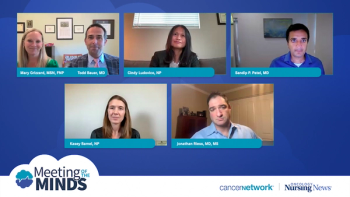
This video segment discusses the efficacy and safety profile of adagrasib for KRAS-positive metastatic NSCLC, drawing insights from the KRYSTAL-1 trial data to inform treatment sequencing decisions.

Your AI-Trained Oncology Knowledge Connection!


This video segment discusses the efficacy and safety profile of adagrasib for KRAS-positive metastatic NSCLC, drawing insights from the KRYSTAL-1 trial data to inform treatment sequencing decisions.

A 58-year-old retired teacher treated with adagrasib for KRAS+ metastatic NSCLC.
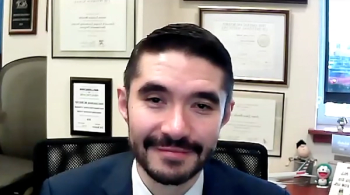
Artificial intelligence may have the potential to enrich pathology practices to help identify aspects of tumor biology not seen with the human eye.
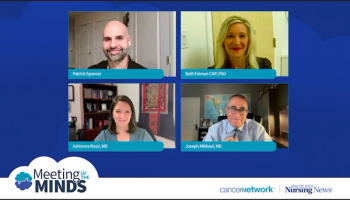
This segment explores Dr. Rossi's clinical experience with cilta-cel as a second-line therapy, focusing on its efficacy and quality-of-life benefits across diverse patient populations.

This segment examines the evidence supporting cilta-cel in second-line therapy, highlighting key outcomes from the CARTITUDE trials and comparing them to other available second-line treatment options for multiple myeloma.

Panelists discuss how the treatment landscape for patients with transplant-ineligible/deferred newly diagnosed multiple myeloma (NDMM) is expected to evolve, with considerations for optimizing therapeutic approaches based on emerging data from novel drug combinations and treatment strategies.
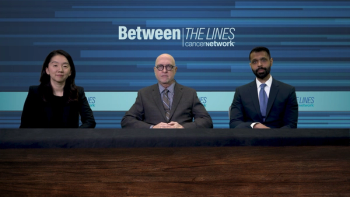
Panelists discuss how the adoption of immunotherapy-chemotherapy combinations in clinical practice requires careful consideration of both long-term safety profiles and sustained efficacy data. A 5-year follow-up period generally provides valuable insights into delayed adverse events and durability of response, which helps inform risk-benefit assessments. The balance between safety and efficacy should be evaluated on a patient-specific basis, considering factors such as performance status, comorbidities, and tumor characteristics.

Panelists discuss how successful implementation of chimeric antigen receptor (CAR) T-cell therapy in relapsed/refractory multiple myeloma (R/R MM) depends on early referral, coordinated care between academic and community centers, standardized protocols for patient management, and careful consideration of product selection and timing based on individual patient factors.

Panelists discuss how managing a 68-year-old patient with newly diagnosed multiple myeloma (MM) with suboptimal response to Dara-VRd (daratumumab plus bortezomib, lenalidomide, and dexamethasone) requires careful consideration of timing for CAR T referral, product selection, and bridging strategies, while balancing the patient’s preference against standard transplant options in the context of non-high-risk disease.

Panelists discuss how the long-term follow-up data from CheckMate649 are crucial for understanding the durability of nivolumab plus chemotherapy’s benefit in first-line advanced gastric cancers (GCs)/gastroesophageal junction cancers (GEJCs). The survival outcomes help validate this regimen’s position as a standard of care, particularly for patients with PD-L1 combined positive score (CPS) ≥ 5. Although the magnitude of benefit varies by PD-L1 expression, both overall survival (OS) and progression-free survival (PFS) data inform personalized treatment decisions, with stronger evidence supporting immunotherapy use in higher PD-L1–expressing tumors while maintaining use across most patient subgroups.

Panelists discuss how frailty assessment influences treatment decisions in patients with transplant-ineligible newly diagnosed multiple myeloma (NDMM), particularly examining the IFM2017-03 study’s evaluation of a dexamethasone-sparing approach using daratumumab plus lenalidomide in frail patients.

Efficacy results from the MASAI trial preceded the creation of the UK-funded EDITH trial, assessing 5 AI platforms in 700,000 women undergoing mammography.

Findings from DESTINY-Breast06 showed a PFS of 13.2 months for patients given T-DXd for HER2-low or ultralow breast cancer.

Combining sotorasib with panitumumab may reduce the burden of disease in patients with KRAS G12C-mutated metastatic colorectal cancer.

Dr. Kim provides an overview of the clinical evidence supporting lorlatinib as a first-line therapy for ALK+ metastatic NSCLC, focusing on the key efficacy outcomes from the phase 3 CROWN trial.

Dr. Garon discusses the factors that make a patient a strong candidate for ALK inhibitor therapy in ALK+ NSCLC, the importance of biomarker testing in guiding treatment selection, and his approach to testing along with challenges encountered, especially in community settings.

Aditya Bardia, MD, MPH, FASCO, spoke about how the FDA approval of T-DXd in HER2-low or ultralow breast cancer will allow for a broader treatment range.

Findings from the phase 2b ReNeu trial show significant pain relief with mirdametinib in adult and pediatric patients with NF1-PN.

Findings from the CodeBreak 300 study have cemented sotorasib/panitumumab as a third-line treatment option for KRAS G12C-mutated colorectal cancer.

The dispersible tablet formulation of mirdametinib may offer convenience to patients with NF1-PN and difficulty with swallowing pills.
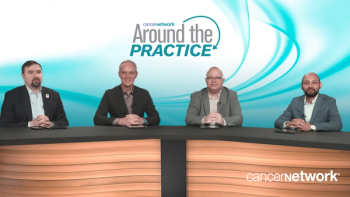
Panelists discuss key strides made in 2024, including exciting data presented at the 66th American Society of Hematology Annual Meeting and Exposition (ASH 2024), and reflect on pivotal developments, such as new insights into Bruton tyrosine kinase inhibitors, that are shaping clinical practice while looking ahead to 2025 with anticipation for continued advancements that will further enhance treatment strategies and patient outcomes.

Panelists discuss how findings from the phase 3 PALOMA-3 trial of subcutaneous amivantamab plus lazertinib may impact clinical practice, in particular the improvement of patient outcomes and how their preferences will play a role in treatment decisions.

Panelists discuss how bispecifics, like teclistamab, are administered at their institutions, the monitoring of cytokine release syndrome (CRS) and immune effector cell–associated neurotoxicity syndrome (ICANS) during step-up dosing, and strategies to improve care transitions between academic centers and community practices. They also highlight the potential for outpatient administration of bispecifics, as seen in the OPTec and Ambulatory Teclistamab studies, emphasizing the benefits of patient convenience and safety.

Panelists discuss the supportive care measures Julia considers for patients with advanced EGFR-mutant NSCLC, including interventions like nutrition and exercise, to enhance overall well-being and support treatment outcomes.

Panelists discuss the side effects Melinda has experienced with her current treatment and the strategies she has found most helpful in managing them, while Julia outlines her typical monitoring and follow-up procedures for patients receiving amivantamab, including the frequency of follow-up visits, labs, imaging, and the symptoms or labs that are most concerning during follow-up.

Panelists discuss how bispecifics are sequenced with other B-cell maturation antigen (BCMA)–targeted therapies, such as chimeric antigen receptor (CAR) T cells or antibody drug conjugates (ADCs), and whether early vs late relapse impacts treatment strategies for relapsed/refractory multiple myeloma (R/R MM), with emphasis on how biological and clinical factors influence decision-making.

Panelists discuss the safety and efficacy data from the phase 3 PALOMA-3 trial, and how they may lead to future considerations of the subcutaneous use of amivantamab with lazertinib in the front line.

Sotorasib plus panitumumab may offer improved survival compared with previously approved treatment options in KRAS G12C-mutated colorectal cancer.

Panelists discuss how sacituzumab shows significant efficacy in triple-negative breast cancer, with improved progression-free and overall survival. It demonstrates particular benefit in pretreated patients and brain metastases cases. Trastuzumab deruxtecan (T-DXd) excels in HER2-positive breast cancer treatment, showing remarkable response rates and survival benefits, including in patients with brain metastases and those who progressed on prior therapies.

Panelists discuss how the approach to metastatic disease focuses on systemic therapy, as cancer has spread beyond its primary site. Treatment typically combines targeted therapy, immunotherapy, chemotherapy, and/or hormonal therapy based on cancer type and molecular profile. Goals shift toward extending survival, controlling symptoms, and maintaining quality of life rather than cure. Regular monitoring of treatment response and adverse effects guides ongoing care decisions.